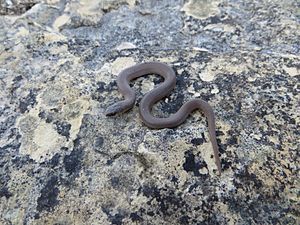Smooth earth snake facts for kids
The smooth earth snake (Virginia valeriae) is a small, non-venomous snake found in the eastern half of the United States. It's a type of colubrid snake, which means it's part of a very large family of snakes. Don't worry, this snake is completely harmless to humans!
Quick facts for kids Smooth earth snake |
|
|---|---|
 |
|
| from Madison County, Iowa | |
| Conservation status | |
| Scientific classification | |
| Synonyms | |
|
Contents
About the Smooth Earth Snake
The smooth earth snake got its scientific name, valeriae, from a woman named Valeria Biddle Blaney. She was the first person to collect a specimen of this snake in Maryland. She was also a cousin of Spencer Fullerton Baird, one of the scientists who officially described the snake in 1853.
What Does It Look Like?
Smooth earth snakes are usually brown, ranging from a light tan to a darker brownish-gray color. Their bellies are much lighter, often a pale pink or grayish-white. Sometimes, they might have a faint light line down their back. They can also have tiny black spots on their back and sides.
These snakes are quite small. Adults are typically about 7 to 10 inches (18 to 25 cm) long. The longest one ever recorded was about 13 inches (33.7 cm).
Where Does It Live?
You can find the smooth earth snake across a large part of the eastern United States. Their range stretches from states like Texas and Iowa all the way to New Jersey and Florida.
Habitat and Diet
The smooth earth snake is a fossorial species. This means it spends most of its time underground or hidden. It likes to burrow in loose soil or hide under leaf litter. This helps it stay safe and find its favorite foods.
What do these little snakes eat? They mainly munch on earthworms. They also enjoy other soft-bodied arthropods, which are creatures like insects or spiders.
Behavior and Safety
Smooth earth snakes are generally not aggressive towards people. They are quite shy and prefer to stay hidden. If you happen to find one, it's harmless. Their mouths and teeth are too small to cause any real injury to humans.
If a smooth earth snake feels threatened, it might try to scare you away by releasing a smelly liquid. This is a defense mechanism to make itself less tasty to predators. If you need to move one, you can safely pick it up gently by hand and place it somewhere safer.
Subspecies of Smooth Earth Snake
There are three recognized types, or subspecies, of the smooth earth snake. They are all very similar but have slight differences in where they live or how their scales look.
- Western Earth Snake (Virginia valeriae elegans): This subspecies usually has 17 rows of scales on its back. It lives in the western parts of states like Indiana, Kentucky, and Tennessee. Its range extends west to eastern Kansas and central Texas.
- Mountain Earth Snake (Virginia valeriae pulchra): This type of smooth earth snake has scales that are slightly ridged, or "keeled." You can find it in the mountains of western Pennsylvania and nearby areas of West Virginia and western Maryland.
- Eastern Earth Snake (Virginia valeriae valeriae): This is the most common type and has 15 rows of scales on its back. It lives from New Jersey down to Georgia, and west through northern Alabama, Tennessee, and southern Ohio.
Reproduction and Life Cycle
Smooth earth snakes give birth to live young, usually in August. They don't lay eggs like some other snakes. A mother snake typically has fewer than 10 babies at a time. When they are born, the baby snakes are very tiny, only about 2.5 inches (6 cm) long.


